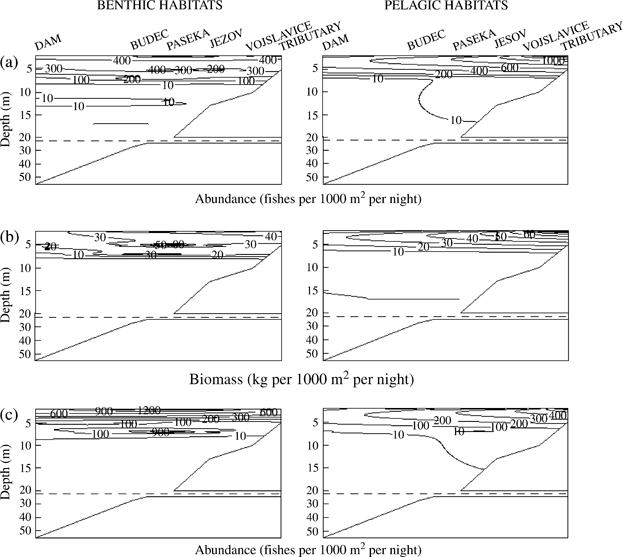 In August 2004 and 2005, an extensive study of the fish community was carried out in the largest water supply reservoir in the Czech Republic and Central Europe, the canyon-shaped Želivka Reservoir, using a fleet of Nordic multimesh gillnets. Fishes were sampled at eight locations along the longitudinal profile of the reservoir and at five benthic depth layers covering depths from the surface down to 18 m (benthic gillnet 1.5 m high), and at three pelagic depth layers down to the depth of 5 m above the bottom (pelagic gillnets 4.5 m high). Catches of both juvenile (age 0+ year) and adult (fishes >1 year) fishes were highest in the upper layers of the water column (i.e. in the epilimnion down to 5 m, and down to 10 m in the benthic habitats). Along the tributary–dam axis in the pelagic habitats, both juvenile and adult fishes preferred the upper part of the reservoir, where the maximum number of species and also the greatest abundance of zooplankton were found. In the benthic habitats, fishes selected location according to factors other than trophic status. More juvenile fishes were recorded in the benthic habitats than in the pelagic habitats. Depth had the largest explanatory power for predicting fish community composition, followed by the affiliation with benthic and pelagic habitats, and location on the longitudinal axis of the reservoir. The fish community was represented mainly by cyprinids and consisted of two distinct groups of species, with bleak Alburnus alburnus, rudd Scardinius erythrophthalmus and asp Aspius aspius dominating the offshore group while perch Perca fluviatilis and ruffe Gymnocephalus cernuus were affiliated with the inshore group of the adult fish community. Roach Rutilus rutilus, bream Abramis brama and pikeperch Sander lucioperca occurred in important proportions in both the inshore and the offshore zones. All species, with the exceptions of adult perch (1+ year and older), 0+ year perch and 0+ year roach, preferred the most eutrophic tributary part of the reservoir. The fish community was relatively stable between the 2 years sampled.
In August 2004 and 2005, an extensive study of the fish community was carried out in the largest water supply reservoir in the Czech Republic and Central Europe, the canyon-shaped Želivka Reservoir, using a fleet of Nordic multimesh gillnets. Fishes were sampled at eight locations along the longitudinal profile of the reservoir and at five benthic depth layers covering depths from the surface down to 18 m (benthic gillnet 1.5 m high), and at three pelagic depth layers down to the depth of 5 m above the bottom (pelagic gillnets 4.5 m high). Catches of both juvenile (age 0+ year) and adult (fishes >1 year) fishes were highest in the upper layers of the water column (i.e. in the epilimnion down to 5 m, and down to 10 m in the benthic habitats). Along the tributary–dam axis in the pelagic habitats, both juvenile and adult fishes preferred the upper part of the reservoir, where the maximum number of species and also the greatest abundance of zooplankton were found. In the benthic habitats, fishes selected location according to factors other than trophic status. More juvenile fishes were recorded in the benthic habitats than in the pelagic habitats. Depth had the largest explanatory power for predicting fish community composition, followed by the affiliation with benthic and pelagic habitats, and location on the longitudinal axis of the reservoir. The fish community was represented mainly by cyprinids and consisted of two distinct groups of species, with bleak Alburnus alburnus, rudd Scardinius erythrophthalmus and asp Aspius aspius dominating the offshore group while perch Perca fluviatilis and ruffe Gymnocephalus cernuus were affiliated with the inshore group of the adult fish community. Roach Rutilus rutilus, bream Abramis brama and pikeperch Sander lucioperca occurred in important proportions in both the inshore and the offshore zones. All species, with the exceptions of adult perch (1+ year and older), 0+ year perch and 0+ year roach, preferred the most eutrophic tributary part of the reservoir. The fish community was relatively stable between the 2 years sampled.
Keywords: fish community structure; gillnets; longitudinal distribution; vertical distribution; water supply reservoir
